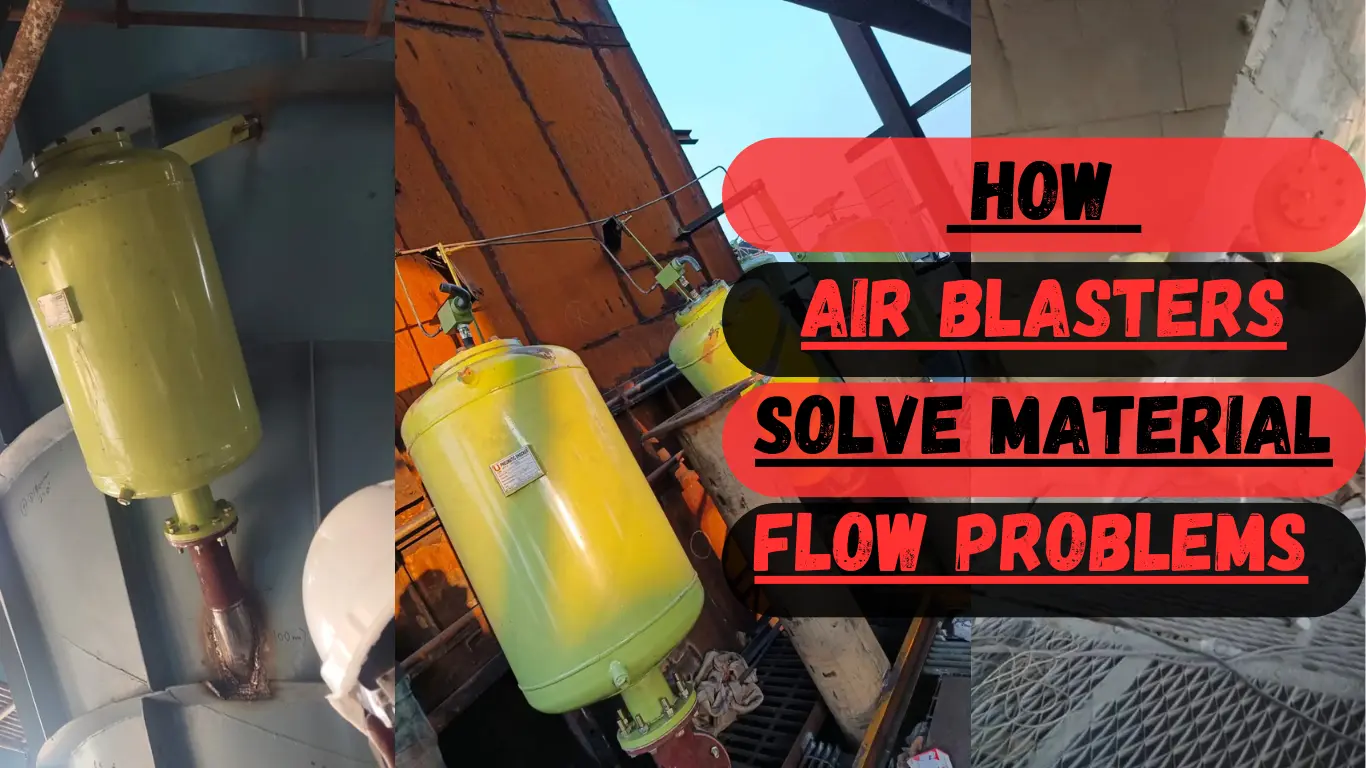How Industrial Air Blasters Solve Material Flow Problems
Bulk material flow problems can cripple industrial operations. Think about trying to get ketchup out of a glass bottle held upside down, or a dump truck bed fully raised while a stubborn load still clings inside—same physics, different scale. In plants, these issues turn into blockages, rat-holes, and costly downtime. Industrial vibrators and air blasters are proven tools to restore smooth, reliable flow. Here’s how they work—and how to pick the right approach.
What Is Bulk Material Handling (Bulk Solids)?
“Bulk solids” are non-fluid particulate materials produced, stored, and transported without individual packaging. They move through hoppers, silos, chutes, and conveyors—often by gravity—and their behavior depends on particle size, shape, moisture, and friction.
- Common storage: hoppers, silos, bins, stockpiles.
- Common transport: railcars, self-unloading ships, bulk bags, and trucks.
Typical Examples of Bulk Solids
- Kaolin clay — ceramics, papermaking, rubber.
- Bauxite — aluminum production, bricks, refining.
- Steel production materials — iron ore, manganese, dolomite, ferrosilicon.
- Cement — essential binder in construction.
- Sand & gravel — construction and landscaping.
- Sulfur, lime, wood chips, sawdust — various process inputs.
- Coal, coke, taconite — energy and steelmaking.
When gravity alone can’t overcome friction, cohesion, or compaction, flow-aids like vibration and air blasting turn a bottleneck back into a pipeline.
Ubon India Process Engineering
Storage of Bulk Solids & Why Flow Problems Arise
Bins and hoppers are designed with sloped walls to encourage gravity discharge, but gravity isn’t always enough. Materials compact, absorb moisture, or cling to walls, creating partial or complete blockages that starve downstream equipment and force unplanned stoppages.
Why Do Bulk Solids Have Flow Issues?
- Hopper design: Inadequate wall angles/finish or poor outlet geometry.
- Moisture content: Water increases cohesion; materials stick and bridge.
- Compaction: Head pressure compresses material and locks particles together.
- Friction: High wall or particle friction resists movement.
- Improper loading: New material compacts older layers; segregation worsens flow.
- Density/temperature changes: Properties shift with ambient or process conditions.
Common Material Flow Problems
- Bridging/arching: Material forms a self-supporting arch across the outlet.
- Ratholing: A central channel empties while material clings along the walls.
- Clinging/buildup: Adhesive layers reduce live capacity and choke discharge.
Solving Flow Problems: How Industrial Vibrators Help
Properly selected and mounted industrial vibrators reduce wall friction, loosen compacted zones, and “re-fluidize” bulk solids so gravity can do its job. The result: smooth, controlled discharge without hammering or manual poking.
How Vibrators Restore Flow
- Introduce controlled energy to overcome friction and cohesion.
- Prevent compacted “stuck” layers from forming near the walls.
- Enable consistent mass-flow or reliable funnel-flow, depending on design.
- Reduce the need for manual intervention and mechanical impact.
General Guidelines: Match Speed & Force to the Material
- Amplitude-sensitive (large/heavy): Coal, rock, gravel → lower frequency, higher amplitude.
- Frequency-sensitive (fine powders): Salt, cement, flour → higher frequency, lower amplitude.
- Light & airy: Wood chips → lower frequency, higher force to initiate flow.
- Heavy but fine: Solar salt → high force and high frequency (turbine/roller vibrators excel).
Air Blasters: A Powerful Complement (or Stand-Alone Solution)
Where vibration alone can’t break stubborn bridges or thick buildups, air blasters (air cannons) deliver short, high-energy bursts of compressed air through nozzles to shear, lift, and dislodge material. They’re invaluable at chutes, transfer points, kilns, cyclones, and high-capacity hoppers across sponge iron, cement, steel, power, coal, sugar, and mining plants.
- Targeted impact: Nozzle geometry focuses energy exactly where buildup occurs.
- Automated cycles: Pneumatic control panels time shots for prevention—not just cure.
- Less downtime: Clear blockages without manual entry or hammering.
- Equipment friendly: Reduces wear from scraping and impact methods.
Conclusion: Rely on Ubon India for Reliable Bulk Flow Solutions
Keeping bulk materials moving is essential to productivity and safety. The right combination of industrial vibrators and air blasters eliminates bridging, ratholing, and buildup—cutting downtime and maintenance costs.
Ubon India designs, supplies, and services high-performance air blasters, nozzles, and control panels—plus vibrator solutions— tailored to your material, vessel geometry, and duty cycle. From cement and steel to mining and power, our engineered systems deliver consistent, long-term results.
Talk to our engineering team to diagnose your flow issues and implement a proven fix—so your process runs smoother, safer, and more profitably.
